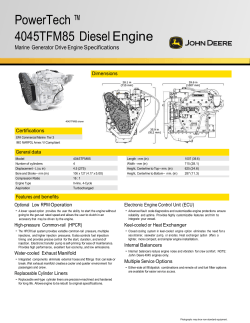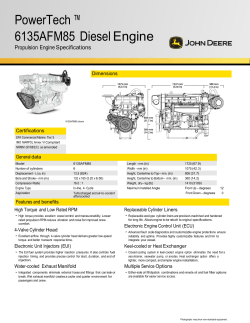
“LS3” 6.2L V8 2009 Marine Engine One of GM’s newest
2009 One of GM’s newest marine engines “LS3” 6.2L V8 Marine Engine Features & Benefits ¶High flow cylinder head design to improve exhaust port flow ¶Enhanced valvetrain enables a more direct intake port ¶Returnless fuel injection with stainless steel fuel rail ¶Intake ports revised to match new cylinder head. The new composite intake manifold is manufactured with a lost core process to improve runner to runner variation and to reduce flow losses. Acoustic foam is sandwiched between the outside top of the intake manifold and an additional “skull cap” acoustic shell to reduce radiated engine noise. Structural enhancements have been added to the manifold bosses. ¶Larger bore block with structural improvements improves block structure and bay to bay breathing ¶Pistons include design enhancements for the higher engine output Factory-installed EFI hardware, including coil-near-plug ignition, is standard on the “LS3” 6.2L V8 marine engine. ¶Higher flow injectors ¶Beauty cover has a revised appearance and acoustic treatment Available Options MEFI-5 (Marine Electronic Fuel Injection - FifthGeneration), is an advanced engine controller capable of meeting all the emissions, OBD-M and driveability requirements of marine applications. ¶An electronic control module (ECM) and related hardware are available in kit form. The ECM uses state-of-the-art technology to optimize fuel and spark control. ¶ “LS3” Sight Shield and related mounting hardware are available in kit form. ¶GM-designed accessory drive components will be available in kit form. 2009 “LS3” 6.2L Feature Focus Considered by many as a key member in our “Image” engine category, the “LS3” is continuing as an offering for marine applications in the 2009 model year. The LS3 exceeds customer expectations with outstanding overall performance. Induction System Improvements (Intake manifold flow path) The LS3 engineering team focused on design elements to increase flow efficiency in addition to the displacement increase, to meet the performance enhancement. The bore was increased to a larger 103.25 mm diameter compared to the LS2 bore of 101.6. Engine stroke remains at 92.0 mm. Intake flow efficiency was optimized by straightening out and optimizing the flow path from the intake manifold into the cylinder heads. A high flow efficiency induction system is borrowed from the Z06 application. The cylinder head exhaust ports have been modified to increase flow. High Flow Cylinder Heads and Enhanced Valvetrain The intake port size and shape have been modified to increase flow. Casting changes were made to increase the opening at the exhaust face to improve exhaust port flow. A new exhaust manifold opening is required to match the heads. The inlet rocker arm is offset 6 mm between the valve tip and rocker bolt/push rod to enable a more direct intake port. The intake valve diameter is increased from 50.8 to 55.0 mm. Hollow stem intake valves were implemented to enable the higher engine rpm capability (13% reduction in mass from LS2). The exhaust valves are 40.4 mm in diameter. Carryover LS2 high load valve springs are also included for higher rpm capability. Intake lift increases from 13.25 mm to 14.0 mm. Exhaust lobes are carryover LS2. Camshaft timing is revised. Additional Features Additional Features ¶Superior engine sealing system features one-piece rear main seal, one-piece front crankshaft seal, and controlled-compression gaskets on the oil pan, front cover, raised rail rocker arm covers, and intake manifold ¶Cast-iron crankshaft has undercut and rolled fillets for durability ¶Metric fasteners used throughout ¶100% cold testing performed at engine plant to verify product quality 2009 Specifications 900 800 TORQUE (lb-ft) 450 418 hp (312 kW) @ 5400 rpm 400 700 350 600 300 500 400 200 300 150 200 100 100 50 0 0 0 10 20 30 40 50 60 70 ENGINE SPEED (rpm x 100) Actual power levels may vary depending on OEM calibration and application. Plot depicted represents Chevrolet Corvette (base exhaust model) Actual power levels may vary depending on OEM calibration and application. Fuel Shutoff: OEM Defined Materials: Block: Cast Aluminum Cylinder Head: Cast Aluminum Intake Manifold: Composite Exhaust Manifold:Cast Nodular Iron Main Bearing Caps: Powder Metal Crankshaft: Cast Iron with Undercut and Rolled Fillets Camshaft: Hollow Steel Connecting Rods: Forged Powder Metal Additional Features: Extended Life Spark Plugs Oil Level Sensor GM Powertrain www.gmpowertrain.com © 2008 General Motors Corporation PRINTED IN U.S.A. 01/31/08 250 424 lb-ft (575 Nm) @ 4600 rpm 705 (27.75) 710 (27.95) 716 (28.19) 716 (28.19) HORSEPOWER (hp) Type: 6.2L Gen-IV V8 Small Block Displacement: 6162 cc (376.0 ci) Compression Ratio: 10.7:1 Valve Configuration: Overhead Valves (2 valves per cylinder) Assembly Site: St. Catharines, Ontario Valve Lifters: Hydraulic Roller Firing Order: 1 - 8 - 7 - 2 - 6 - 5 - 4 - 3 Bore x Stroke: 103.25 x 92 mm Fuel System: Port Fuel Injection Fuel Type: Premium Fuel Recommended Engine Orientation: Longitudinal Valves Per Cylinder: 2 Bore Center (mm): 111.76 Engine Mass: TBD Application: Chevrolet Corvette (Base Exhaust Model) Emission Controls: Positive Crankcase Ventilation (PCV) Horsepower: 418 hp (312 kW) @ 5400 rpm SAE CERTIFIED Torque: 424 lb-ft (575 Nm) @ 4600 rpm SAE CERTIFIED
© Copyright 2025





















